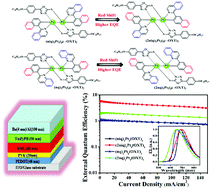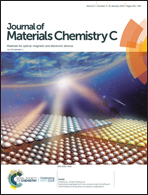Molecular isomeric engineering of naphthyl-quinoline-containing dinuclear platinum complexes to tune emission from deep red to near infrared†
Abstract
Four isomeric dinuclear platinum complexes of (C^N)2Pt2(μ-OXT)2 are synthesized and characterized with different C^N cyclometalating ligands and the same ancillary ligand of 5-(4-octylphenyl)-1,3,4-oxadiazole-2-thiol (μ-OXT). These isomeric C^N ligands are 1-naphthyl-1-isoquinoline (niq), 2-naphthyl-1-isoquinoline (2niq), 1-naphthyl-2-quinoline (nq) and 2-naphthyl-2-quinoline (2nq). The isomeric effect on the photophysical, electrochemical and electroluminescence properties of (C^N)2Pt2(μ-OXT)2 was systematically studied. It is found that the emissions were easy to tune from deep red to near infrared for (C^N)2Pt2(μ-OXT)2 by changing the C^N isomers. Furthermore, the complexes with 2-naphthyl presented better electroluminescence (EL) properties than the complexes with 1-naphthyl in these solution-processable polymeric light-emitting devices. In contrast to the (2nq)2Pt2(μ-OXT)2-doped devices displaying a deep-red emission peaked at 686 nm with an external quantum efficiency (EQE) of 3.21%, the (2niq)2Pt2(μ-OXT)2-doped devices exhibited a near-infrared emission peaked at 704 nm with a significantly increased EQE of 8.86% and a radiant emittance of 986 μW cm−2. Our research provides an efficient strategy to tune emission from deep red to near infrared by a simple isomeric engineering of dinuclear platinum(II) complexes.



 Please wait while we load your content...
Please wait while we load your content...